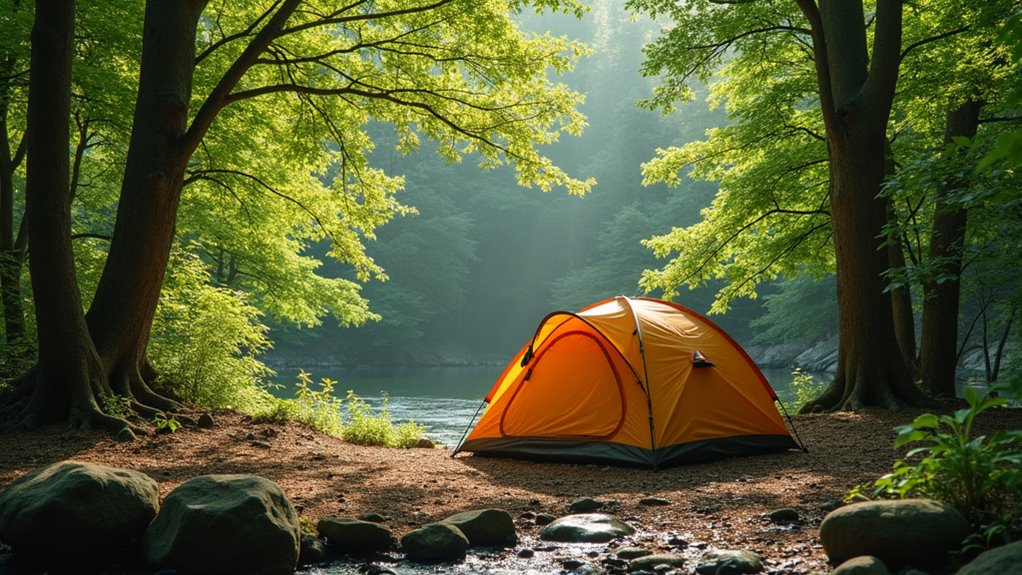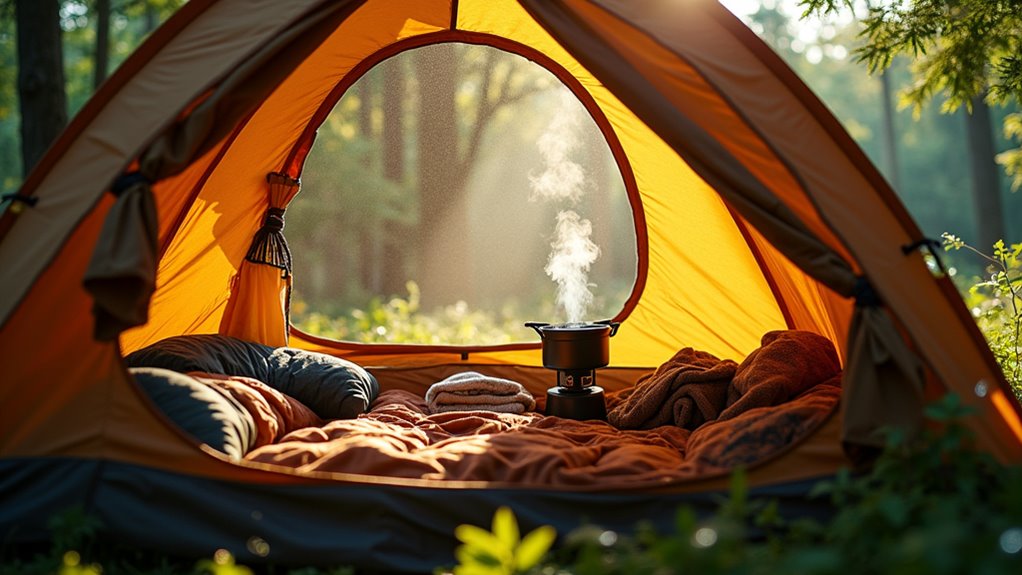How To Keep Moisture Out Of Tent
This post contains affiliate links. As an Amazon Associate, we earn from qualifying purchases.
To keep moisture out of your tent, select a high, sloped site for proper water drainage and ensure good ventilation by opening all vents and positioning the door to catch the breeze. Additionally, manage internal dampness by storing wet clothes outside and cooking away from the tent. Regularly check for dryness and use silica gel packs to help absorb moisture. For improved moisture control, consider using a double-walled tent. Further details and techniques to maximize your tent’s dryness will be explained below.
Essential Facts in 30 Seconds
- Pitch your tent on elevated, slightly sloped ground to avoid moisture buildup.
- Choose tents with breathable waterproof materials and double walls for better airflow.
- Keep wet gear outside or sealed in waterproof bags to reduce humidity inside.
- Fully open vents and windows to improve air circulation and cut down condensation.
- Dry your tent completely before packing and check it regularly for dampness during storage.
Choosing the Right Location for Your Tent

Pick a high spot for your tent. Cold air sinks into low areas. This causes more wetness inside the tent. Avoid places like dips or small valleys. These spots trap moisture and fog.
Find ground that slopes slightly. Water will flow away and keep the tent dry. Make sure the soil feels firm and dry. Muddy ground adds dampness inside. Stay away from lakes and streams. They add extra moisture and cause wet tents. Additionally, selecting elevated ground helps reduce the risk of water accumulation around the tent.
Plant your tent under strong trees. Trees give shade and keep warmth inside. Warm air means less water on tent walls. Press the soil with your foot. If it squishes or feels soft, move to drier ground. Additionally, creating a small trench around the tent perimeter can help channel water away from your setup.
These tips help keep tents dry and camping fun.
Effective Ventilation Techniques
Effective ventilation keeps your tent dry and comfortable on camping trips. Good airflow stops dampness and stuffy air inside the tent. Open all built-in vents fully. Place the door and windows on opposite sides. This lets fresh air flow in and pushes humid air out.
| Ventilation Method | Purpose |
|---|---|
| Open tent vents fully | Let natural air move through |
| Position door in breeze | Help air flow across the tent |
| Keep windows partly open | Increase inside air movement |
| Raise tent slightly | Allow air to flow beneath tent |
Tents with tension ridge design have higher peaks. These peaks improve air movement inside the tent. Check vents often and change their openings based on the weather. Control airflow well to stop wetness buildup. Additionally, a well-ventilated tent reduces moisture buildup and ensures a more enjoyable camping experience. Proper knowledge of condensation can help you understand how to maintain a dry, fresh tent and a better camping experience.
Managing Internal Moisture Sources

Managing moisture inside your tent keeps your space dry and comfy. Your breath releases warm, wet air that makes tent walls damp. To combat this, remember that proper ventilation techniques can significantly reduce condensation buildup.
Keep movement low to cut down sweat and breath moisture. Store wet clothes outside or in waterproof bags, never inside the tent. Additionally, cooking and boiling water only outside can avoid extra humidity. Use silica gel packs to soak up moisture. Place your sleeping spot away from tent walls and use waterproof liners on sleeping bags.
These steps help stop dampness and make camping more enjoyable.
Tent Maintenance and Preparation
Make sure your tent is completely dry before packing. Dry tents stop mold and mildew from growing. Take the rainfly off the inner tent. This helps air flow and dries the fabric faster. Additionally, it’s important to check the tent’s seams and corners for retained moisture. Put moisture absorbers, like silica gel packs, inside the tent bag. They keep the tent dry and fresh during storage. Store your tent in a cool, dry place away from direct sun. This care keeps your tent ready for your next trip. Additionally, regular checks for dampness can prevent future issues and ensure your tent remains in optimal condition.
Thoroughly Dry Before Packing
Always dry your tent well before packing it away.
Set up the tent in the sun with good airflow. Open all doors and vents to help air move inside. Shake off any water and use microfiber towels to wipe damp spots. Turn the tent inside out now and then to dry every part. Properly drying your tent helps prevent mildew and odors from developing, as moisture can lead to mold if left unchecked.
Dry the tent indoors only if the weather outside is bad. Avoid using machines or heat to dry the tent. Heat can harm the fabric and cause damage. Store the tent in a loose, breathable bag after it’s fully dry. Check your tent often to keep it in great shape.
Dry tents last longer and stay free from mold and bad smells.
Separate Rainfly From Inner
Separating the rainfly from the inner tent keeps the inside dry and comfy. This gap stops cold spots that cause water drops inside.
Use rainflies made of polyester. They stay tight and don’t sag when wet. A tight rainfly with stakes and lines stops water from pooling.
Check the setup often. Adjust for wind or ground movement. Use pullouts and vestibules to let air flow inside.
A tight, separated rainfly helps keep the tent warm and dry. It also makes your tent last longer.
Use Moisture Absorbers Inside
Moisture absorbers inside your tent keep it dry and comfy. Use these options:
- Rechargeable dehumidifier bags with water-attracting crystals
- Silica gel packets for light humidity control
- Clay-based absorbers that you can reuse
- Activated charcoal to cut moisture and bad smells
- Special products made just for tents
Keep absorbers working well by recharging bags when color changes.
Put them in good spots inside the tent. Never dry wet clothes or gear inside.
Use moisture absorbers and open vents for fresh air. This protects your stuff and stops mold or mildew.
Dry tents make camping better.
Structural and Fabric Considerations
A tent with two layers helps keep moisture away and stops condensation.
Breathable waterproof fabric allows air to flow, cutting down humidity inside.
Keep the tent fabric tight during setup to avoid water pooling and leaks.
This simple care keeps your shelter dry and comfortable.
Double-Walled Tent Design
A double-walled tent design helps keep campers dry and comfortable. It uses two layers: an inner breathable tent and an outer waterproof rainfly. This design reduces dampness and controls condensation well.
Benefits include:
- Gear stays dry and safe
- Less humidity inside the tent
- Air flows between the two layers
- Warmer inside by blocking drafts
- Easy access with multiple doors
The inner tent’s breathable fabric lets vapor escape. This stops water droplets from forming inside. The rainfly blocks rain and wind. Features like vestibules and vents help air move and keep moisture out.
Double-walled tents work great in changing weather. They make camping more pleasant and cozy.
Breathable Waterproof Fabrics
Breathable waterproof fabrics keep your tent dry and comfortable. Polyester and nylon are common choices. They’ve breathable coatings that manage moisture well.
Polyester fights mold and mildew, great for wet weather. Silnylon is light and waterproof but can stretch when wet.
Poly-cotton blends feel strong and comfy. Tech cotton offers good texture and breathability.
Laminated fabrics block water but let vapor escape. The right fabric lets air flow but stops rain. This helps you stay dry and cozy outdoors.
Choose fabrics that balance waterproofing with breathability. Your tent will perform better in all weather.
Tautness and Fabric Management
Keep your tent fabric tight to stop dampness during camping trips. Tight fabric stops sagging, which traps moisture and causes humidity.
Follow these simple steps to manage your tent fabric well:
- Pull the tent body and rain fly tight.
- Use adjustable guy lines and stakes for perfect tension.
- Check fabric tension often and tighten if needed.
- Face your tent toward the wind for better airflow.
- Keep fabric away from gear and sleeping bags.
These tips keep your tent dry and comfortable.
Dry tents mean better sleep and less worry.
Behavioral and Environmental Controls
Set up camp on dry, high ground. Avoid low spots where water collects. Stay away from lakes or streams to cut down moisture in the air. Trees above can warm the air and help keep your tent dry.
Face your tent door toward the wind. This moves fresh air inside. Pull the rainfly tight to stop water from touching the tent walls. Open vents and windows to let moist air escape fast.
Keep wet clothes and shoes outside your tent. This stops dampness inside.
These simple steps reduce moisture and make your camping more comfortable. Dry tents mean better sleep and fewer bugs.
Frequently Asked Questions
What Materials Are Best for Reducing Tent Moisture Absorption?
Breathable fabrics like canvas and polycotton work best to reduce tent dampness. These materials block moisture well and help control tent temperature. They stop water from building up inside. This keeps your camping space dry and comfortable. Many campers trust canvas and polycotton for these reasons. They balance air flow with water resistance. Your tent stays fresh, even in wet weather.
How Does Temperature Affect Condensation Levels Inside a Tent?
Nighttime cold causes water drops on your tent walls. Warm air inside meets cold tent fabric. This change turns moisture in the air into water droplets. Cooler temperatures increase these drops. Warmer nights mean less condensation inside. Proper ventilation helps move moist air outside. Keeping air dry lowers water build-up inside tents.
Can Using a Tarp Help Manage Tent Moisture?
Using a tarp helps control moisture inside your tent. It stops wet ground from making the tent damp. A tarp also lets air flow better. This air flow lowers water drops inside the tent. Your tent stays dry and comfy all night. Many campers use tarps to keep their tents fresh. It’s a simple way to avoid wet gear and cold nights.
What Are Some Signs of Excessive Moisture in a Tent?
Most campers, about 90%, notice signs of moisture inside their tents. Water droplets often form on tent walls. A musty smell is common too. High humidity outside adds moisture inside. Temperature changes cause water to collect. Breathing inside the tent also raises dampness. These signs make camping less comfortable. Keep tents dry to enjoy your trip.
How Can I Prevent My Sleeping Bag From Getting Damp?
Keep your sleeping bag dry by placing a tarp or groundsheet underneath it. Avoid touching tent walls, as moisture can seep through. Open your tent and air out the sleeping bag each day to stop dampness. Use a waterproof stuff sack to store the bag when not in use. These steps help reduce moisture and keep you warm at night.
Conclusion
Keep your tent dry to enjoy a comfortable camping trip. Pick a spot that is high and flat, away from puddles or low areas. Open tent vents and windows to let air move inside. This stops moisture from building up. Avoid cooking or drying wet clothes inside the tent. Use a ground tarp under your tent to block water from the soil. Store wet gear outside or in a separate bag. These simple steps stop dampness and make your tent a cozy shelter. Stay dry, stay happy. Enjoy your camping adventure!
